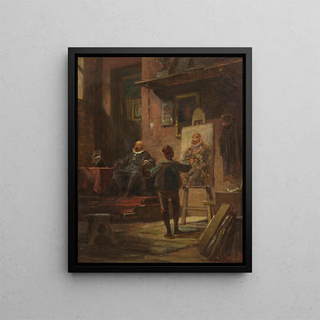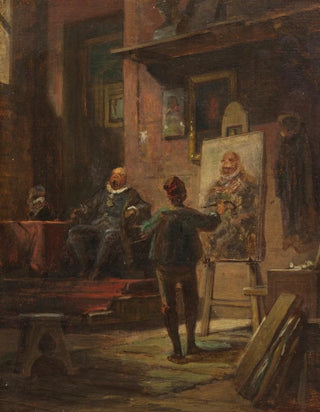Art print | The painter in the studio - Carl Spitzweg Source: Reproduction | Le peintre dans l'atelier - Carl Spitzweg


View from behind

Frame (optional)
In the vibrant world of art, some works manage to capture the very essence of creativity and inspiration. "The Painter in the Studio" by Carl Spitzweg falls into this privileged category. This canvas, emblematic of the 19th century, immerses us in the heart of an artist's studio, a place where imagination transforms into reality. Spitzweg, with his keen eye and sharp attention to detail, invites us to explore the subtleties of a painter's daily life, while revealing the magic emanating from each brushstroke. The scene unfolds in an intimate atmosphere, making this artwork a true homage to artistic passion.
Style and uniqueness of the work
Carl Spitzweg's style is characterized by delicacy and tenderness that permeate each of his compositions. In "The Painter in the Studio," he manages to combine realism and romanticism, offering a vision that is both faithful and poetic of an artist's life. Warm colors and soft lighting create a serene ambiance, while meticulous details, such as painting tools and sketches hanging on the walls, testify to attentive observation of everyday life. The work also stands out for its ability to evoke universal emotions. The painter, absorbed in his work, embodies the quest for inspiration—a recurring theme in art. Spitzweg succeeds in capturing this essence, rendering the scene both accessible and deeply moving.
The artist and his influence
Carl Spitzweg, an iconic figure of German art, established himself as one of the masters of Romanticism. His career, marked by a diversity of themes ranging from daily life to more fantastical scenes, demonstrates unparalleled creative richness. Spitzweg influenced many artists with his unique approach to painting, blending humor and melancholy. His works, often imbued with a certain nostalgia, invite reflection while celebrating the beauty of the world around us. "The Painter in the Studio" is no exception to this rule, as it embodies both the passion for art and the solitude of the

Matte finish

View from behind

Frame (optional)
In the vibrant world of art, some works manage to capture the very essence of creativity and inspiration. "The Painter in the Studio" by Carl Spitzweg falls into this privileged category. This canvas, emblematic of the 19th century, immerses us in the heart of an artist's studio, a place where imagination transforms into reality. Spitzweg, with his keen eye and sharp attention to detail, invites us to explore the subtleties of a painter's daily life, while revealing the magic emanating from each brushstroke. The scene unfolds in an intimate atmosphere, making this artwork a true homage to artistic passion.
Style and uniqueness of the work
Carl Spitzweg's style is characterized by delicacy and tenderness that permeate each of his compositions. In "The Painter in the Studio," he manages to combine realism and romanticism, offering a vision that is both faithful and poetic of an artist's life. Warm colors and soft lighting create a serene ambiance, while meticulous details, such as painting tools and sketches hanging on the walls, testify to attentive observation of everyday life. The work also stands out for its ability to evoke universal emotions. The painter, absorbed in his work, embodies the quest for inspiration—a recurring theme in art. Spitzweg succeeds in capturing this essence, rendering the scene both accessible and deeply moving.
The artist and his influence
Carl Spitzweg, an iconic figure of German art, established himself as one of the masters of Romanticism. His career, marked by a diversity of themes ranging from daily life to more fantastical scenes, demonstrates unparalleled creative richness. Spitzweg influenced many artists with his unique approach to painting, blending humor and melancholy. His works, often imbued with a certain nostalgia, invite reflection while celebrating the beauty of the world around us. "The Painter in the Studio" is no exception to this rule, as it embodies both the passion for art and the solitude of the






